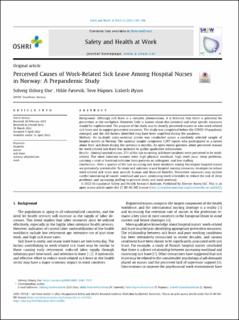| dc.contributor.author | Ose, Solveig Osborg | |
| dc.contributor.author | Færevik, Hilde | |
| dc.contributor.author | Håpnes, Tove Rigmor | |
| dc.contributor.author | Øyum, Lisbeth | |
| dc.date.accessioned | 2023-03-01T15:09:51Z | |
| dc.date.available | 2023-03-01T15:09:51Z | |
| dc.date.created | 2022-10-11T13:48:17Z | |
| dc.date.issued | 2022 | |
| dc.identifier.citation | SH@W Safety and Health at Work. 2022, 13 (3), 350-356. | en_US |
| dc.identifier.issn | 2093-7911 | |
| dc.identifier.uri | https://hdl.handle.net/11250/3055095 | |
| dc.description.abstract | Background: Although sick leave is a complex phenomenon, it is believed that there is potential for prevention at the workplace. However, little is known about this potential and what specific measures should be implemented. The purpose of the study was to identify perceived reasons to take work-related sick leave and to suggest preventive measures. The study was completed before the COVID-19 pandemic emerged, and the risk factors identified may have been amplified during the pandemic.
Methods: An in-depth cross-sectional survey was conducted across a randomly selected sample of hospital nurses in Norway. The national sample comprised 1,297 nurses who participated in a survey about their sick leave during the previous 6 months. An open-ended question about perceived reasons for work-related sick leave was included to gather qualitative information.
Results: Among hospital nurses, 27% of the last occurring sick leave incidents were perceived to be work-related. The most common reasons were high physical workload, high work pace, sleep problems, catching a viral or bacterial infection from patients or colleagues, and low staffing.
Conclusions: Over a quarter of the last occurring sick leave incidents among Norwegian hospital nurses are potentially preventable. To retain and optimize scarce hospital nursing resources, strategies to reduce work-related sick leave may provide human and financial benefits. Preventive measures may include careful monitoring of nurses’ workload and pace, optimizing work schedules to reduce the risk of sleep problems, and increasing staffing to prevent stress and work overload. | en_US |
| dc.language.iso | eng | en_US |
| dc.publisher | Elsevier | en_US |
| dc.rights | Attribution-NonCommercial-NoDerivatives 4.0 Internasjonal | * |
| dc.rights.uri | http://creativecommons.org/licenses/by-nc-nd/4.0/deed.no | * |
| dc.title | Perceived Causes of Work-Related Sick Leave Among Hospital Nurses in Norway: A Prepandemic Study | en_US |
| dc.title.alternative | Perceived Causes of Work-Related Sick Leave Among Hospital Nurses in Norway: A Prepandemic Study | en_US |
| dc.type | Peer reviewed | en_US |
| dc.type | Journal article | en_US |
| dc.description.version | publishedVersion | en_US |
| dc.rights.holder | © 2022 Occupational Safety and Health Research Institute, Published by Elsevier Korea LLC. | en_US |
| dc.source.pagenumber | 350-356 | en_US |
| dc.source.volume | 13 | en_US |
| dc.source.journal | SH@W Safety and Health at Work | en_US |
| dc.source.issue | 3 | en_US |
| dc.identifier.doi | 10.1016/j.shaw.2022.04.002 | |
| dc.identifier.cristin | 2060502 | |
| dc.relation.project | Norges forskningsråd: 237779 | en_US |
| cristin.ispublished | true | |
| cristin.fulltext | original | |
| cristin.qualitycode | 1 | |

